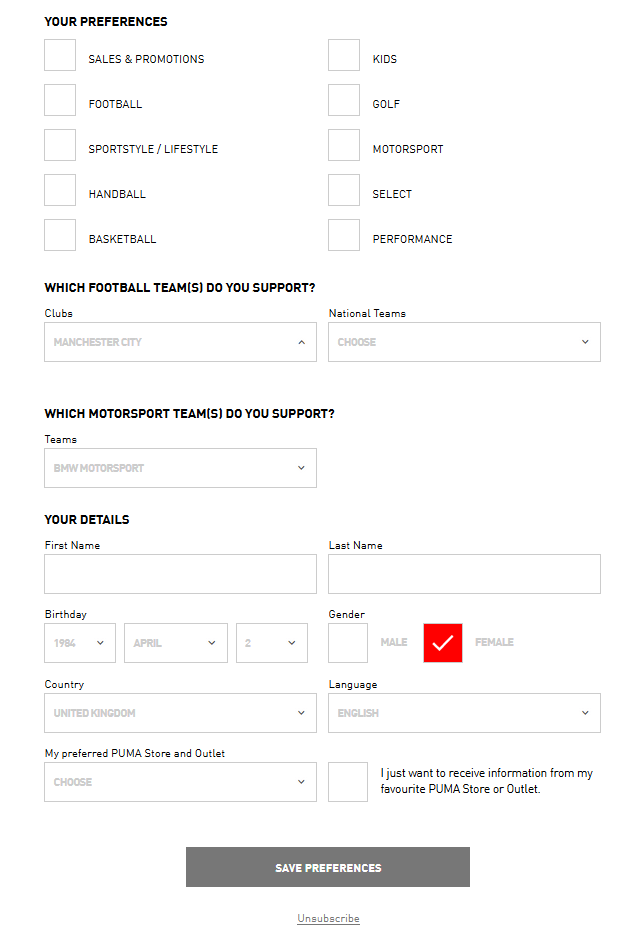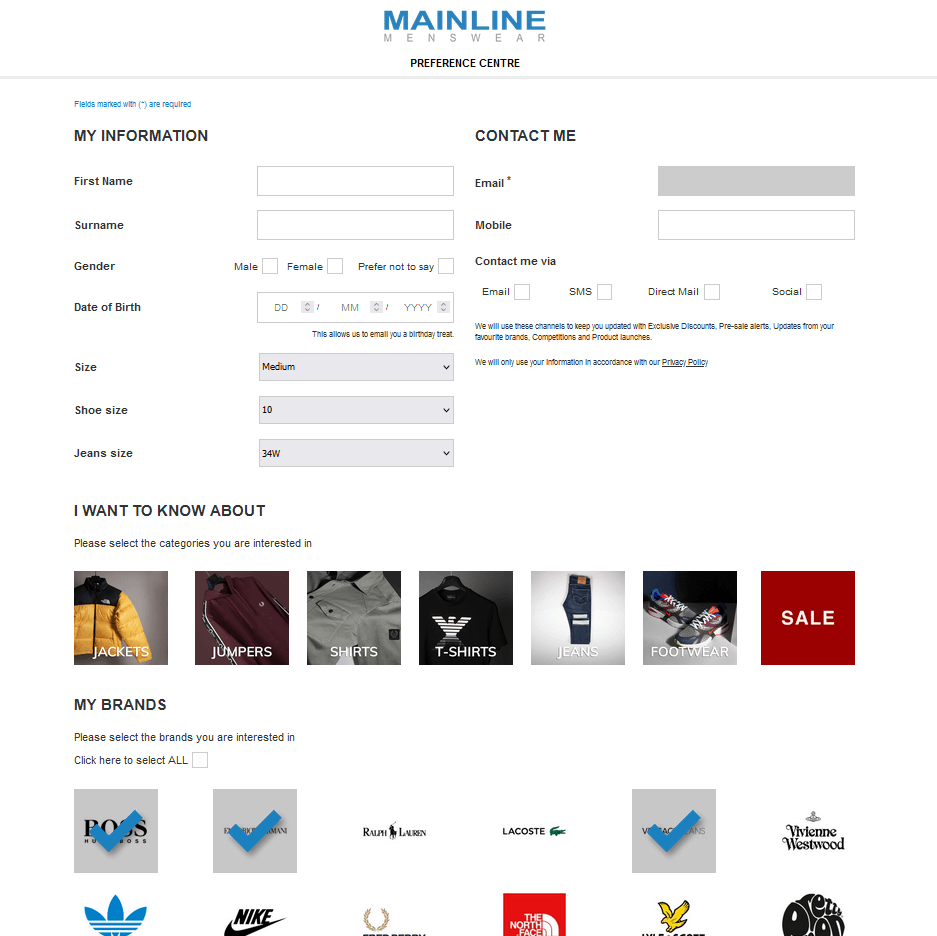Preference centres go a long way in taking out the guess work in what makes your subscribers tick. And getting your subscribers to tell you exactly what they want gives you, and them, more control!
Quick reference
- What is a preference centre?
- Preference centre examples
- 10 reasons why email marketers need to use a preference centre
- Used correctly a preference centre reduces your unsubscribe rates over time
- Why preference centres are crucial in developing meaningful customer segmentation
- What personalisation could an email marketer implement into their creatives based off preference centre data?
- The worst mistake you could make by using a preference centre
What is a preference centre?
Simply put, a preference centre is a form that customers can fill in to update their profile with more information. They can:
- Manage contact preferences such as Email, SMS, Push and more
- Update contact information
- Manage frequency of contact
- Provide demographic information such as birthday
- Choose what type of content to receive
- Provide personal interests
However, to call a preference centre a form, whilst correct, doesn’t do it any justice. Preference centres are the key to managing an effective and well thought out marketing communications strategy via automation.
They are the powerful end result and the customer facing view of this strategy, allowing subscribers to self-segment, choose which channels they prefer, inform what creative direction you take with them and ultimately offer a customer experience they expect to receive from a brand that knows them well.
Preference centre examples
Here’s some great examples of brands using preference centres to deliver a better customer experience…
Blacks

What’s great about this example from Blacks is they collect DOB, perfect for those Birthday Email Campaigns, in addition to gender but also who I shop for, meaning when it comes to customer segmentation by gender they won’t exclude purchases who buy for friends and family.
The activities and favourite brands options look amazing compared against a default checkbox form option. The segmentation that this creates will be invaluable.
Puma

This sleek, minimalist design gets straight to the point. Puma service a lot of sports, so it’s important for them to only send relevant campaigns to which sport a subscriber is interested in.
The options to select favourite football clubs and motorsport teams offers that added layer of detailed personalisation. Choosing a preferred store also taps into location based personalisation.
size?

The size? preference centre has a clever four stage process to swipe through, breaking up what would otherwise be a long form. This makes it much easier to complete. The final step is a great example of how to display channel preferences.
The user is in full control of which channel size? can use to send them campaigns and is more likely to select additional channels they may have been unaware of.
Mainline Menswear

Like Blacks, Mainline Menswear’s preference centre makes use of image-based checkboxes to create a very pleasing design. Mainline can effectively segment on preferred brands and type of clothing.
They also ask for sizing information, meaning they can offer hyper-personalised campaigns based on this data – perfect for promoting either new launches or excess stock in certain sizes.
Travelodge

Preference centres can be expanded beyond the capture of interests. And in this Travelodge example they use a snooze option for subscribers wishing to pause their opt-in.
It’s a fantastic way of keeping a contact active in your database and not losing them for good by completing a hard opt-out. Travelodge give a 1 month, 3 month and 6 month snooze options for their subscribers.
This type of snooze preference centre can be used for a variety of events too, check out our articles on Mother’s Day and Father’s Day campaign opt-outs. Also view our Papa John’s case study featuring snooze functionality which saw a 30% decrease in the number of email unsubscribes.

10 reasons why email marketers need to use a preference centre
1. Accurate segmentation
With more accurate and up-to-date information about user preferences, you can segment your customer database more effectively and send targeted campaigns that are more likely to be relevant to the subscriber.
2.Improved personalisation
With more information about user preferences, you can create more personalised email and SMS campaigns that will be relevant to the customer.
3. Superior data quality
By allowing subscribers to update their information, you can maintain more accurate data which can help to avoid sending emails to invalid or non-existent email addresses.
4. Better Insights
No one knows more about your customers than themselves! By gathering information about user preferences, you’ll gain insights into what types of emails and content are most popular, which can help to improve future campaigns.
5. Increased deliverability
By providing subscribers with the option to opt in or out of certain email campaigns, you’ll reduce the number of emails that are marked as spam, which can help to improve email deliverability.
6. Reduced unsubscribes
By giving subscribers the ability to control their email preferences, they are less likely to unsubscribe from all emails allowing you to still communicate with them on topics that will make them more likely to purchase.
7. Improved campaign performance
By gathering more information about user preferences, you’ll improve the performance of your campaigns. Based on preferences you can test different subject lines, calls to action, product hero content and other elements to see what resonates best with that preference/interest group.
8. An improved customer experience
Giving subscribers control over the emails and other channels they receive, leads to a better customer experience and increased customer satisfaction.
9. Increased revenue
By sending more targeted and relevant emails, you’ll see an increase in revenue from your marketing campaigns. This can include higher conversion rates and increase in repeat purchases as you’re hitting the sweet spot your customers are looking for.
10. Increased trust and loyalty
By giving subscribers control over the frequency of emails and the type of content they receive, you’ll build trust and loyalty with your customers.
That’s a lot of great reasons! Let’s explore three of them in a little more detail…

Used correctly a preference centre reduces your unsubscribe rates over time
Ultimately, you’re targeted with increasing the total size of your contactable database and increasing repeat purchases. Ensuring you keep a low unsubscribe rate is critical to meet these objectives. The preference centre is your best friend when it comes to lowering unsubscribe rates:
Increased relevance
By allowing subscribers to choose the types of emails they receive and how often they receive them, the email preference centre can ensure that the emails sent are more relevant and enjoyable for subscribers, reducing the likelihood of unsubscribes.
Better segmentation
By gathering more information about subscribers’ preferences and behaviours, you can segment your campaigns more effectively, ensuring that the right emails are being sent to the right people at the right time, reducing the number of unsubscribes.
Increased control
By giving subscribers more control over the emails they receive, you’ll increase the overall satisfaction of subscribers, reducing the likelihood of unsubscribes.
Reduced fatigue
By reducing the number of irrelevant and unwanted emails, SMS or push messages, the preference centre will help prevent fatigue in your subscribers, which can be a major cause of unsubscribes, especially those brands that send out daily email campaigns.
Improved messaging
By allowing subscribers to update their contact information and email preferences, improve communication is the end result which will reduce the number of unsubscribes due to inaccurate data or outdated preferences.

Why preference centres are crucial in developing meaningful customer segmentation
Once a subscriber has self-segmented and provided more profile data, the opportunities for effective segmentation explode.
Preference and interest data can be used to segment the customer base into different core groups based on what details they’ve selected. For example, a subscriber may list skateboarding and BMX as a core interest.
A brand may have a preference centre that allows subscribers to opt in or out of certain types of email campaigns, such as new product launches, advice and tips, Black Friday sales events.
Based on the choices the subscriber makes, you can segment your customer database into different groups, such as those who are interested in product launches, those who are interested in advice articles, and those who are interested in sales events.
This can go even further into brand level preferences. For example, ecommerce sites that sell designer brands can ask their subscribers to select which brands they want to receive updates from such as Hugo Boss, Emporio Armani, Versace, etc.
Rather than sending the same generic message to the entire email list, you can now use dynamic content and personalisation to tailor parts of your email to match the brand preferences or interests of your subscribers.
This increases the chances of the email being relevant and interesting to the recipient, which can lead to higher engagement and conversion rates.
Preference centres that allow subscribers to update their contact information such as home address, can be used to segment customers based on their location. For brands that operate stores, this can be invaluable in targeting customers with specific store events or launches.

What personalisation could an email marketer implement into their creatives based off preference centre data?
There’re several really great ways to use personalisation based off preference centre data…
Content personalisation
By gathering information about a subscriber’s interests and preferences, targeted emails with content that is more relevant to the user is achieved.
For example, if a subscriber has indicated that they are interested in outdoor activities, you can use dynamic content to always include content related to hiking and camping products in your email creative.
Product personalisation
Using a customer’s purchase history together with their preference centre data is a powerful mix. You could send targeted emails with product recommendations that are more likely to be of interest to the user.
For example, if a customer has purchased Nike trainers in the past, you can use marketing automation to send emails with new Nike releases. Doubled up with knowing their exact shoe size, you can even micro-personal content based on what’s in stock.
Timely personalisation
Behaviour based preferences are great in increasing engagement. It opens up the possibility to send timely emails that are more likely to be opened by the customer.
For example, if a subscriber has indicated that they prefer to receive emails in the morning, you can schedule emails to be sent at that time.
Location based personalisation
Knowing a customer’s location or preferred location is great for personalisation. You could send targeted emails and SMS with location based offers.
For example, if a customer is located within the drive-time of a new store opening, you could send an email with offers or events happening to celebrate.
Demographics personalisation
Whilst demographic data may be harder to come by than preference and interest, when given you’ve earned the trust and respect of the customer. This data is a gold mine for more sophisticated and intricate marketing campaigns based on their age, income and profession.
However, you can start small with demographics. Use simple gender based product personalisation and go from there.
Check out more personalisation advice from our two articles data driven personalisation and contextually driven personalisation.

The worst mistake you could make by using a preference centre
Preference centres sound amazing – and they are. However, the worst possible mistake you could make is launching an all-singing, all-dancing preference centre without having the marketing automation strategy in place to handle the requests.
It may seem tempting to build the preference centre first and include lots of different interests, brand likes, contact frequency and channel preferences but unless you can commit to honouring those, you’ll only serve to disappoint your customers.
When providing personal information to your brand, customers are involving themselves in a transaction – to receive more relevant and personalised communications.
If they go to the trouble of completing a preference centre and select options such as Male, Evening Emails, Lake District, Rab & Montane, Hiking; yet you continue to send generic email blasts with no reference to any of these then you run a high risk of damaging your reputation and trust. It would be better not to offer a preference centre at all.
With the help of RedEye, many of our clients are successfully running preference centres to send out personalised campaigns to their customers.
The power of marketing automation, to create segments, in real time, from a subscriber’s preference data coupled with our dynamic content and personalisation editor for building unique email creatives for each segment makes the marketer’s life easier to meet customer expectations.
Enjoyed this article? Sign-up to receive updates




